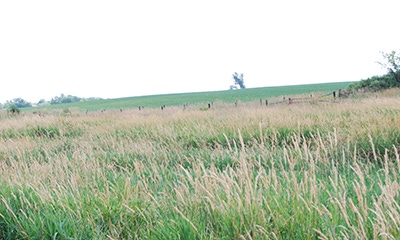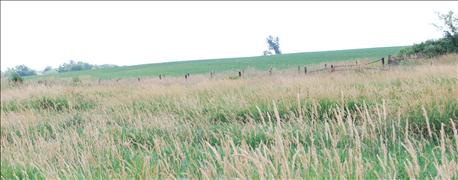
FAQ: USDA recently announced results of the Conservation Reserve Program’s latest sign-up period. USDA says a record number of farmers want to participate in CRP but many are being turned away because, by law, USDA can’t accept any more land into the program. Please explain.

POPULAR PROGRAM: USDA recently announced Conservation Reserve Program sign up results for the latest CRP sign-up period. For fiscal year 2016 more than 800,000 acres were selected through the highly competitive application rounds.
Answer: The latest sign-up results released May 5 do indeed show a record number of farmers and ranchers wanting to participate in the CRP program, says John Whitaker, executive director of USDA’s Farm Service Agency (FSA) in Iowa. USDA announced the enrollment of more than 800,000 acres into the CRP nationwide. That includes the acres enrolled during the recently completed 49th general sign-up period, the new acres in the Grassland CRP, and the continuous CRP program acres which have been signed up since November 2015.
As of March 2016, a total of 23.8 million acres were enrolled in the entire CRP program across the U.S., with 1.7 million acres set to expire this fall. Over the years, new contracts enter new acres into the program and expiring contracts that aren’t renewed result in acres coming out of CRP. The 2014 Farm Bill established a cap on the number of acres that may be enrolled in CRP. For fiscal year 2016 it is 24 million acres. For fiscal years 2017 and 2018, the cap remains at 24 million acres.
The Conservation Reserve Program, created in 1985, pays landowners an annual rent to idle environmentally fragile land for 10 years or more. Farmers are paid for establishing long-term vegetation (approved grasses or trees) to control soil erosion, improve water quality and enhance wildlife habitat. USDA’s Farm Service Agency handles the CRP program.
CRP acreage cap limits the number of acres
“There is a lot of interest in the CRP program but we are limited in the number of farmers and landowners we can sign up, because we have an acreage cap for the program,” explained U.S. Secretary of Agriculture Tom Vilsack in a recent interview.
For many years, enrollment in CRP was 30 million to 36 million acres, but Congress lowered that total in the 2014 Farm Bill to 24 million acres. At that time farmers were dealing with significantly higher commodity prices, and lawmakers believed producers were more likely to keep land in production rather than remove it and put it in the CRP. The farm bill also was promoted as a way to cut $23 billion in spending and the CRP program was among those programs targeted to save money.
What will CRP look like in next farm bill?
“When Congress begins working on 2018 Farm Bill, they will be working under a different set of assumptions as it relates to the Conservation Reserve Program,” says Vilsack. “As Congress prepares for the 2018 Farm Bill, they really do need to look at more than saving money in establishing the number of CRP acres.”
U.S. Sen. Joni Ernst, R-Iowa, says “The CRP will be an important part of the upcoming discussions regarding the next farm bill.” That’s partly because of high demand for the program from farmers facing low crop prices and a slumping ag economy, she notes.
Iowa’s other U.S. Sen., Chuck Grassley, also a Republican, says increasing the number of acres allowed in the CRP “will certainly be looked at” during the debate on the next farm bill. “When you are putting together a new farm bill, everything is on the table,” he says. Grassley and Ernst are both members of the Senate Ag Committee which is in charge of writing the farm bill.
Latest sign-up will enroll 800,000 new acres
USDA announced on May 5 it will enroll more than 800,000 acres in fiscal 2016, bringing the estimated total to 23.8 million acres in the CRP. Of the 800,000 new acres, Iowa will have 128,212 of them: the most of any state. Currently, Iowa has about 1.6 million total acres enrolled in CRP on more than 52,800 farms.
“Iowans are constantly looking for ways in which they can protect that precious resource, their land and water,” says Vilsack, “and do it in a way that is economically sustainable as well.”
USDA said with a record number of farmers and ranchers interested in participating in CRP, the ag department could not accept all the land without exceeding the 24 million acre threshold. Vilsack says 1.5 million acres from interested farmers were not accepted.
Payments are also an incentive to participate
With low crop prices, USDA officials say the CRP payments are attracting more farmers who want to put acres into CRP.
Dan Hansen, farming in Audubon County in west-central Iowa and raising corn, soybeans and livestock, says he decided to stop growing crops on 45 acres of his lower-producing land and is considering enrolling an additional 80 acres. Together the land would total about 20% of his acreage. CRP is paying him nearly $300 an acre, a more stable return than how much he could have generated by farming with today’s volatile commodity markets.
Hansen also is saving money on labor and input costs he doesn’t have to pay, since he is farming those lower-yielding acres. “CRP is a guaranteed payment,” he notes. “Whereas, cropping the land, you don’t know what you are going to get, from year to year.”
With low crop prices, it’s harder to make money
It’s not that you can’t make money in farming the land, but with lower commodity prices, it’s a lot harder to make money.
Environmental policy adviser Rick Robinson at Iowa Farm Bureau Federation says his organization supports CRP but favors the part or option in the program which allows producers to enroll land with certain conservation practices at any time of the year, without competition.
In some cases another enrollment effort, known as the CRP general signup, is where producers with eligible lands compete nationally for acceptance based on environmental benefits. This has resulted in strong competition for the land between the government and young farmers. In a recent period providing an opportunity to enroll acres, USDA offered CRP rental rates that were better than those being offered locally by other farmers and landowners for corn and soybean land.
Do you compete with CRP for rented land?
“We’ve heard such comments from younger farmers trying to rent some acres or rent some pasture, and the frustration of competing with those lucrative CRP rental rates and incentives,” Robinson says. “These farmers were in competition with the government to try to rent those acres. It’s frustrating for the young farmers in such situations.”
Other USDA conservation programs are also available. Since 2009, USDA has invested more than $29 billion to help producers make soil and water conservation improvements, working with as many as 500,000 farmers, ranchers and landowners to protect land and water on over 400 million acres nationwide. To learn more about FSA's conservation programs, visit fsa.usda/gov/conservation or contact a local FSA county office. To find your local FSA county office, visit offices.usda.gov.
About the Author(s)
You May Also Like




